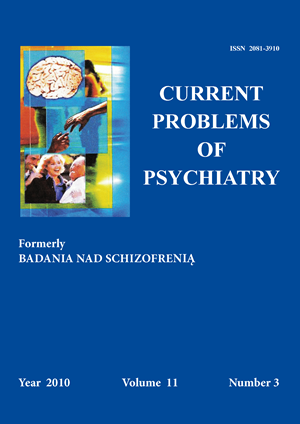Role of motivational factors in the etiology of uncontrolled spending
Keywords:
motivational factors, uncontrolled spendingAbstract
Uncontrolled spending is associated by an average person with a disorder or addiction only to some extent. There is a tendency to rationalise this type of behaviours by explaining to oneself and to other people that they result from thriftlessness or from the lack of ability to save, but this perception changes when excessive spending leads to financial problems, family conflicts and even conflicts with law. It is not until this stage that the persons affected by this problem usually begin to look for specialist help. However, in Polish literature this problem lacks detailed studies. Therefore, this article is intended to outline one of the aspects typical of this disorder.
Thus the first paragraph will show how this phenomenon is viewed upon, it will depict its specific characteristics, its prevalence rate and will inform what kind of help is available. The second one will deal with various motives for pathological spending that are characteristic of uncontrolled spending (compulsive, impulsive, hedonistic buying).
References
1. Thomas P. Świadome zakupy czyli co naprawdę kupujemy. Wrocław; Purana: 2007.
2. Faber J.R., O’Guinn T.C. Compulsive Buying: Review and Reflection. W: Haugtvedt C.P., Herr P., Kardes F. red., Handbook of Consumer Psychology. Mahwah; Lawrence Erlbaum Associates: 2006: 2-23.
3. Mandal A. Nowe nałogi współczesnego człowieka. Probl. Opiekuńczo-Wychowawcze, 2006; 7: 11-15.
4. Marčinko D., Karlowič D. Oniomania – successful treatment with fluvoxamine and cognitive-behavioral psychotherapy. Psychiatr. Danub., 2005; 17(1): 97-100.
5. Tavares H., Lobo D.S., Fuentes D., Black D.W. Compulsive buying disorder: a review and a Case Vignette. Rev. Bras. Psiquiatr., 2008; 30(1):16-23.
6. Gąsiorowska A. Kupowanie kompulsywne – zjawisko, jego determinanty i konsekwencje: przegląd badań. Przegl. Psychol., 2001; 44(4): 463-477.
7. Tavares H. Impulse control disorders: the return of Esquirol’s instinctive monomania. Rev. Bras. Psiquiatr., 2008; 30(1): 1-2.
8. Doliński D. Psychologiczne mechanizmy reklamy. Gdańsk; GWP: 2003.
9. Mącik D. Między przyjemnością a uzależnieniem. Psychologia zakupów nieplanowanych. Toruń; WN GRADO: 2008.
10. Dittmar H. Understanding and Diagnosing Compulsive Buying. W: Coombs R.H. red., Handbook of addictive
1. disorders. A practical guide to diagnosis and treatment. Hoboken; John Wiley & Sons: 2004: 411-450.
11. Woronowicz T. Bez tajemnic o uzależnieniach i ich leczeniu. Warszawa; Instytut Psychiatrii i Neurologii: 2003.
12. 12. Faber J.R., O’Guinn T.C. A clinical screener for compulive buying. J. Cons. Research, 1992; 19:459-469.
13. Dittmar H. Compulsive buying – a growing koncern? An examination of gender, age, and endorsement of materialistic values as predictors. Br. J. Psychol., 2005; 96:467-491.
14. Faber J.R., O’Guinn T.C. Compulsive Buying: a Phenomenological Exploration. J. Cons. Research, 1989; 16(2) 147-157.
15. Benson A.L. Are You an Overshopper?
2. http://www.stoppingovershopping.com/shopping_addiction.htm z dn. 14 października 2009 r.
16. Black D.W., Repertinger S., Gaffney G.R., Gabel J. Family History and Psychiatric Comorbidyty in Persons With Compulsive Buying: Preliminary Findings. Am. J. Psychiatry, 155:1998; 155(7): 960-963.
17. Black D.W. A review of compulsive buying disorder. World Psychiatry, 2007; 6(1): 14-18.
18. Verplanken B., Herabadi A.G., Perry J.A., Silvera D.H. Consumer style and health: The role of impulsive buying in unhealthy eating. Psychol. Health., 2005; 20(4): 429-441.
19. Michell J.E., Redlin J., Wonderlich S., Crosby R., Faber R., Miltenberger R., Smyth J., Stickney M., Gosnell B., Burgard M., Lancaster K. The relationship between Compulsive Buying and Eating Disorders. Inter. J. Eat. Disord., 2002; 32(1): 107-111.
20. Benson A., Gengler M. Treating compulsive buying. W: Coombs R.H. red., Handbook of addictive disorders. A practical guide to diagnosis and treatment. Hoboken; John Wiley & Sons: 2004: 451-491.
21. Camerdese G., Picello A., Bria P. Venlafaxine: Successful treatment in impulsive disorders. Psych. Clin. Neurosciences, 2008; 62: 241-242.
22. Guzman C.S., Filomensky T., Tavares H. Compulsive buying treatment with topiramate, a case report. Rev. Bras. Psiquiatr., 2007; 29(4): 383-384.
23. Grant J.E. Three cases of compulsive buying treated with naltrexone. Int. J. Psychiatry Clin. Pract., 2003; 7: 223-225.
24. Dell’Osso B., Allen A., Altamura A. C., Buoli M., Hollander E. Impulsive-compulsive buying disorder: clinical overview. Aust. N. Z. J. Psychiatry, 2008; 42(4): 259-266.
25. Sędkiewicz J. Uzależnienie od zakupów, czyli zakupoholizm. http://www.ochoroba.pl/artykuly/1443-uzaleznienie-od-zakupow-czyli-zakupoholizm z dn. 13 października 2009 r.
26. Morenberg A. Governing Wayward Consumers: Self-Change and Recovery in Debtors Anonymous.
3. http://etd.fcla.edu/SF/SFE0000449/thesis.final.pdf z dn. 8 października 2009 r.
27. Müller A. Kiedy zakupy stają się nałogiem. Charaktery, 2009; 154(11): 42-45.
28. Benson A.L. Stopping Overshopping Group Telephone Coaching Program.
4. http://www.stoppingovershopping.com/shopaholics_support_groups.htm z dn. 14 października 2009 r.
29. Catalano E.M., Sonenberg N. Consuming passions – help for compulsive shoppers. Oakland; New Harbinger Publications: 1993.
30. Crozier M.K., Rokutani L.J. Broadening the Counselor’s View of Addictions. The Rehab. Coun. Educ. Journ, 2008; 2(2): 60-66.
31. Woodruffe-Burton H., Elliot R. Compensatory Consumption and Narrative Identity Theory. Adv. Consum. Res., 2005; 32: 461-465.
32. Carson R.C., Butcher J.N., Mineka S. Psychologia zaburzeń: człowiek we współczesnym świecie. T1. Gdańsk; GWP: 2005.
33. Bryńska A. Zaburzenie obsesyjno-kompulsyjne. Rozpoznanie, etiologia, terapia poznawczo-behawioralna. Kraków; Wyd. UJ: 2007.
34. McElroy L., Keck P.E., Pope H.G., Smith J.M.R., Strakowski S.M. Compulsive buying: a report of 20 cases. J. Clin. Psychiatry, 1994; 55(6): 242-248.
35. Paluch M., Palacz A. Oniomaniacy – kupujące mózgi bez kontroli? Teksty Pokonferencyjne, 2009;3:130-138.
36. Hollander E., Baker B.R., Kahn J., Stein D.J. Conceptualizing and Assessing Impulse-Control Disorders. W: Hollander E., Stein D.J. red., Impulse-Control Disorders. Arlington; American Psychiatric Publishing: 2006, s. 1-34.
37. Kinsella S. Świat marzeń zakupoholiczki. Warszawa; LIBROS: 2002.
38. Rook D. W. The Buying Impulse. J. Cons. Research, 1987; 14(10): 189-199.
39. O’Shaughnessy J., O’Shaughnessy N.J. Marketing, the consumer society and hedonism. Eur. J. Marketing, 2002; 36(5/6): 524-547.
40. Niewiadomska I., Sikorska-Głodowicz M. Alkohol. Lublin; Gaudium: 2004.
41. Kaul S. Hedonism and Culture: Impact on Shopping Behaviour. A Research Agenda. Vikalpa, 2007; 32(3): 81-89.


